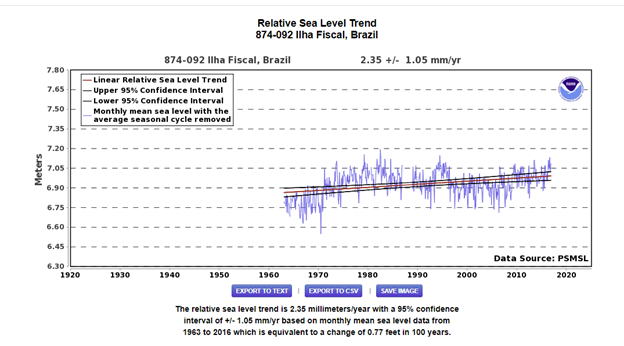The latest victim of climate change appears to be Atafona, Brazil. Or perhaps latest isn’t quite the word. A website called “World Abandoned” describes “A Beach Resort Being Consumed by the Sea” and informs us that “Over the last 40 years, the sea has been eroding away at the beachside district, leaving many of the buildings abandoned and decaying at the hands of nature.” Forty years? But never mind. “In total, 14 blocks have now been swept away including a main promenade, Atlantic Avenue.” Another report claims “Relentless rise in sea levels has turned the coastline into an apocalyptic landscape. The Atlantic Ocean advances an average of six meters a year in the small town.” That’s 18 feet a year, just 300 km up the coast from Rio de Janeiro where, as NOAA’s Tides and Currents page reports, the sea level has been rising for the past 60 years at a rate of… 0.77 inches per century. And zero inches per year over the past 40 years. They don’t even try to be plausible anymore.
Here is the record:

Notice the sea levels rose from the early 60s to the early 80s, then have stalled ever since. But don’t let mere facts get in the way of a good script:
“Once a small idyllic coastal town in the north of Rio Janiero, in Brazil, Atafona has now become a graveyard of wrecked structures with vultures roaming the sand of the resort town. Relentless rise in sea levels has turned the coastline into an apocalyptic landscape. The Atlantic Ocean advances an average of six meters a year in the small town. Atafona, a small town of some six thousand people, has long been prone to extreme erosion and is now exacerbated by climate change. Global warming is causing sea levels to rise and making currents and weather patterns more extreme.”
You are of course pulling our leg, right? Not just with the vultures of the apocalypse. Because if the oceans were rising in this manner so close to the massive Brazilian city of Rio de Janeiro, Rio itself and its 6.7 million people (greater Rio, 12 million) would also be vulture food, or more likely sea cucumber food. Especially as it is on a coastal plain with an average elevation of fully 2 metres above sea level, though it does have spectacular hills 1,000 metres high for people to head to when the rhetorical tide comes for them.
That inane surge of television apocalyptic rhetoric with the vultures ultimately conceded that construction has stripped away the sand dunes and vegetation that used to protect Atafona from the waves. So gee not climate change at all, was it?
No indeed. Even the Wall Street Journal did an “Et tu, brute?” on this one, saying:
“The coastline is receding as much as 18 feet a year at the mouth of the Paraíba do Sul river in Atafona, home to 7,000 people, satellite images show. Between 1984 and 2016, some 550 feet have disappeared. Climate change has increased sea levels, scientists say, and most of the river’s water has been diverted to nearby cities, farms and factories, thwarting its ability to push back the ever-higher waves that sweep away buildings, livelihoods and memories.”
Right. A river delta is being eroded by the sea because humans diverted most of the water that used to bring down silt to cities, farms and factories, so obviously climate change is to blame.
It’s amazing the nonsense you can spew on climate. A Journal diagram of the carnage includes two text boxes, one giving the whole game away and the other taking it back. The first says:
“A part of Convivência island has joined definitively the mainland south, the river flow being no longer sufficient to discharge the estuary sediments into the ocean.”
See, the ocean has been tearing away at the delta on which Atafona sits for thousands of years. But until humans diverted it, the river water brought enough sediment to counteract the erosion. Now it doesn’t. End of story?
No. The other text box blathers that:
“The weak river flow has accelerated the level of sea rise here, destroying hundreds of homes.”
How? How does less water coming down the river and into the, whaddaya call it, oh right, the sea, accelerate the level of sea rise? Normally it would take more water to do such a thing. But climate change is different.
Thus, undaunted, the Journal article raved on that:
“Atafona is an extreme example of the challenge that lies ahead in a country with some 4,600 miles of coastline, one of the world’s longest. Environmental researchers say scores of other beachside communities face similar fates in Brazil, among the top 10 countries that will be most affected by rising sea levels, according to Climate Central, a research organization on climate science.”
How you get ranked among the countries most affected by rising sea levels is not obvious. Though presumably Tibetan journalists are not saying it about their country. (Or saying anything since Tibet is occupied by Communist China, which is happy to have the West cripple itself over climate change but is building coal plants at breakneck speed.) But therein lies the problem an alert reader pointed to while sharing this item with us, namely that 4,600 miles of coastline that are not washing away despite apocalyptic vulture blah blah blah:
“Given the thousands of miles of coastline in South America, all facing the same ocean, why is there erosion just there and not elsewhere?”
Why indeed? Why isn’t the city of Rio at the bottom of the Atlantic? Hint: they didn’t divert all the water from the actual Rio de Janeiro. Which doesn’t run through “Rio” anyway; although rio does mean “river” in Portuguese (and Janeiro is January if you care), it was one of those errors so common in human life including exploration that led Gaspar de Lemos on January 1, 1502 to mistake a bay for a river delta and one thing led to another.
If you care, the real Rio de Janeiro is in the nearby state of Bahia. Possibly they thought they really should have one somewhere to cover the bungle but it’s nothing to write home about. Oh, and while we’re being pedantic, the French actually made the first European settlement at what is now the city of Rio, on an island, and called it Antarctic France in one of those “Let’s call it… Iceland” marketing blunders no one can explain later.



Sorry John ,it’s .77 FEET,per Century. But I get all the rest,even at that it’s the standard 2.75 mm p a
Geoff, not to be pedantic but zero inches per year over the last 40 yrs could close to 0.77 inches per century. But good catch, I’m just being silly. Its amazing how many of John’s pieces make me ga ga actually.
To be fair receding by 6 metres isn’t actually a claim of rising by 6 metres. And if the coastline is very flat a small rise would cause a lot of recess.
Bit of course there’s no justification for claiming it climate change.
There is no place on earth where sea levels are rising 6 meters/20 feet/year.